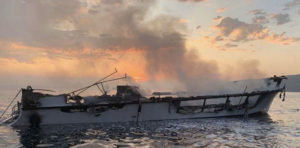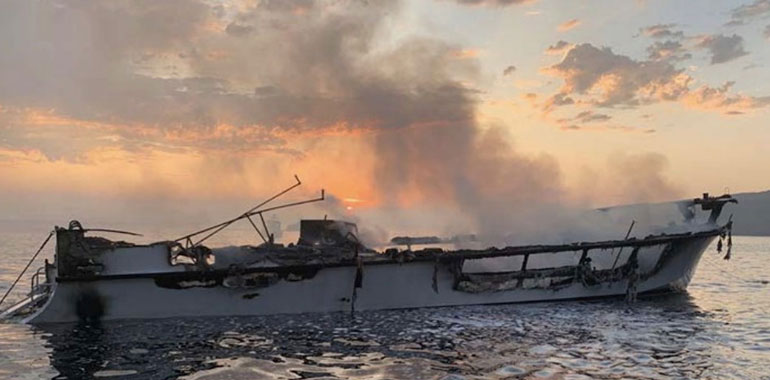
Before dawn on Sept. 2, 2019, a crewman aboard the dive boat Conception awoke to a strange sound. He investigated and found the vessel’s salon compartment, one deck below, aglow with fire.
He awoke four co-workers sleeping nearby, and together they attempted to reach the 34 people sleeping below deck. Flames and intense heat on the main deck made the rescue, or any escape from below deck, impossible. The 33 passengers and one crewmember in the bunk room died.
The National Transportation Safety Board (NTSB) identified numerous regulatory gaps pertaining to passenger vessels during its yearlong investigation of the Conception fire. The agency has called for multiple new rules aimed at improving safety aboard these boats.
NTSB investigators and board members met virtually on Oct. 20 to confirm key findings and release the probable cause of the fire. The agency said the crew’s failure to follow the existing requirement for an overnight watch was a primary factor in the tragedy.
“The absence of the required roving patrol on Conception delayed detection and allowed for the growth of the fire, precluded firefighting and evacuation efforts and directly led to the high number of fatalities in the accident,” the NTSB determined.
The agency attributed those failures to ineffective oversight by vessel owner Truth Aquatics of Santa Barbara, Calif. Other unsafe practices identified during the investigation included insufficient crew training and lack of emergency drills.
“If the company had been actively involved in ensuring the safe practices required by regulations were enforced, most notably the requirement for a roving patrol, it is likely this accident would have not happened,” the NTSB said.
Conception was moored in Platts Harbor north of Santa Cruz Island when the fire started sometime around 0300. The 33 passengers were on the third and final day of a diving excursion around the Channel Islands. There were six crew aboard the vessel.
The captain made a distress call from the burning dive boat before he and four other crewmembers abandoned ship. They launched a skiff and traveled to a nearby sailboat where the captain again requested help over the radio. Two crewmembers returned in search of survivors but found none.
The Coast Guard and other first responders arrived at 0427. By dawn, the 75-foot vessel valued at $1.4 million had burned to the waterline.
At press time, the NTSB had not released its full report. The Coast Guard convened a Marine Board of Investigation and will issue its own findings. Additionally, there is an ongoing federal criminal investigation into the incident.
Investigators could not identify the specific ignition source aboard the vessel or time of ignition. They believe the fire started aft in the passenger salon on the main deck. Most likely ignition sources include the 38-year-old ship’s electrical system, unattended charging batteries or discarded smoking materials, the NTSB said. A photo taken before the fire shows a nest of power strips and electronics charging in the salon.
Investigators believe most of the victims were awake during the fire but were unable to escape. One means of escape was a spiral staircase to the forward salon. The emergency escape hatch, accessible from a bunk bed, also opened to the salon, which was engulfed in flames.
Conception met existing regulations for smoke alarms in bunk spaces. But investigators said the fire would have been well underway by the time smoke triggered the alarms below deck. There was no alarm in the salon, nor any requirement for one.
“Interconnected smoke detectors in all accommodation spaces on Subchapter T and Subchapter K (passenger) vessels would increase the chance that fires will be detected early enough to allow for successful firefighting and the evacuation of passengers and crew,” the NTSB said.
The NTSB called for a series of regulatory changes. These include a requirement for passenger vessels to have smoke alarms in all accommodation spaces, interconnected smoke alarms aboard these vessels and secondary means of egress to a space different from the primary egress. Until then, the agency urged the Passenger Vessel Association and other trade groups to encourage their members to voluntarily make those changes.
Investigators learned there is spotty adherence to the rule requiring overnight watches aboard similar excursion boats. As such, the NTSB urged the Coast Guard to develop protocols to ensure vessels are conducting roving patrols as required.
The Coast Guard said it will consider the NTSB recommendations through a process that will include “review by all subject matter experts and senior leaders responsible for implementing the potential regulatory changes,” said Lt. Cmdr. Brittany Panetta.
“We will look at all possible factors that may have caused this incident, including those associated with regulations or oversight, and make recommendations for any necessary changes,” she said.
Truth Aquatics could not be reached for comment.
Casey Conley

